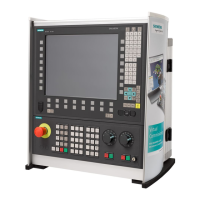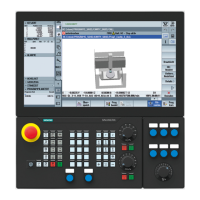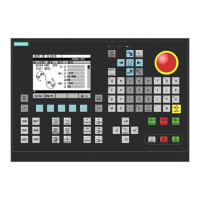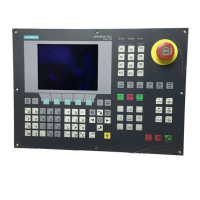Detailed description
2.5 Linking PLC CPUs to 810D, 840D
Power Line Basic PLC Program (P3)
2-26 Function Manual, 08/2005 Edition, 6FC5397-0BP10-0BA0
In the case of NC actions triggered and assigned with parameters by the PLC (e.g., traverse
concurrent axes), triggering and parameter assignment is performed using FCs and FBs, not
interface data blocks. The FCs and FBs belonging to the actions are supplied together with
the basic program. The FCs must be loaded by the user and called in the PLC program of
the machine manufacturer (machine program). You can find an overview of the FC, FB and
DB blocks, divided according to their basic and expanded function, in:
References:
/FB1/ Description of Functions, Basic Machine; PLC Basic Program (P3);
Chapter: Starting Up the PLC Program
OP/PLC interface
Data are exchanged between the OP and PLC via the OP/NC serial bus, COM module and
C bus. The COM module transfers the data intact from one bus segment to another. It
merely converts the baud rate. The OP is always the active partner (client) and the PLC is
always the passive partner (server). Data transmitted or requested by the OP are read from
and written to the OP/PLC interface area by the PLC operating system (timing: Cycle control
point). From the viewpoint of the PLC application, the data are identical to I/O signals.
MCP/PLC interface, HHU/PLC interface (840D only)
Data are exchanged between MCP/PLC and HHU/PLC via the serial bus MCP, HHU/NC,
COM module, and NCK. The NCK transfers the MCP/HHU signals to and fetches them from
the internal NC/NCK DPR (dual-port RAM). On the PLC side, the basic program handles
communication with the user interface. The basic-program parameters define the operand
areas (e.g., I/O) and the start addresses.
MCP/PLC interface, HHU/PLC interface (810D only)
Data exchange between MCP/PLC and HHU/PLC takes place via the MPI interface on the
PLC. The Communication with global data (GD)
1)
service is used for this purpose (see also
STEP7 User's Guide). The PLC operating system handles the transfer of signals from and to
the user interface. The STEP7 Communication configuration configuring tool is used to
define both GD parameters as well as operand areas (e.g., I/O) and their initial addresses. In
SW 2.2 and higher, data exchange is possible as on the 840D.
1)
IC (GD) = Implicit Communication (Global Data)
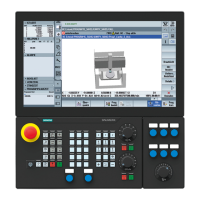
